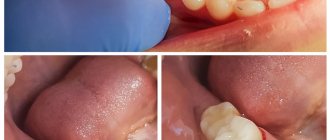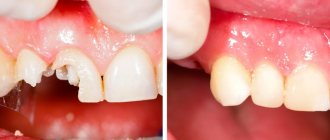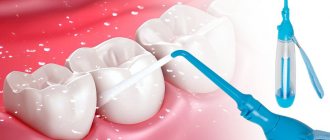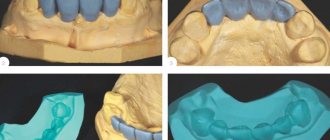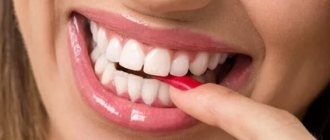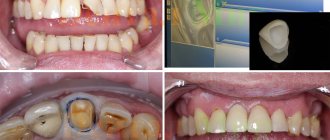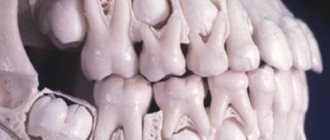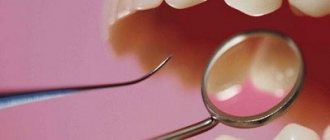8020
Fang augmentation is not only a necessary medical procedure, but also a current fashion trend among teenagers and young adults. In Russia, it became popular after the film adaptation of the famous vampire saga “Twilight”.
You can grow your fangs at any dental clinic. But before deciding on the procedure, you need to study all the features, indications and contraindications.
Why canine extensions are performed, indications
Any adult has four fangs in his mouth - two at the top and two at the bottom. Visually, they are practically no different from other teeth. Some young people, fans of mysticism and the aesthetics of vampirism, turn to the dentist for fang extensions. The procedure allows them to bring their image closer to that of a vampire.
There are also certain medical indications for canine extensions. Only a dentist can prescribe such extensions. The technique is safe and can be performed by almost anyone. There are several ways to lengthen teeth, in most cases the direct method is used. The length of the extended tooth should not exceed 4 mm. It should be taken into account that an elongated tooth in the mouth can create discomfort and there is a risk of injury to the mucous membrane.
Indications for the procedure:
- therapy - extensions are carried out in case of chips or damage to the crown;
- aesthetic goal - whether there is a need to change the size or shape of the tooth;
- orthopedics - extension is carried out when a tooth is completely destroyed and needs to be restored.
The choice of augmentation technique depends on the indications.
What could be the motivation?
Fangs can be extended or restored for dental reasons or for beauty.
For medical purposes, canine extensions are necessary for the following purposes:
- the enamel is damaged or has microcracks;
- the tooth has damage from deep caries or the hard tissue has suffered mechanical damage;
- the tooth wears out with age;
- for defects that cannot be corrected aesthetically;
- There is pronounced pigmentation on the enamel.
In order to improve (change) their appearance, each person makes an independent decision about the advisability of growing fangs.
Over the past few years, this procedure has only gained popularity. Patients are confident that restoration of certain teeth can correct their facial expression and make their smile more mysterious and unusual. They are confident that they will acquire a certain charm and novelty.
In most cases, manipulations on the fangs are performed only for decorative aesthetics.
Advantages and disadvantages
Fang extensions have certain advantages and disadvantages. Advantages of the technique:
- aesthetics;
- durability;
- the possibility of full restoration - restored fangs become natural;
- no load on neighboring teeth;
- the ability to choose a shade;
- painlessness - there are no discomfort during canine extensions;
- the opportunity to change the image.
Flaws:
- high price - often due to the need for additional procedures;
- the possibility of redistributing the load during chewing, which will lead to damage to other teeth;
- risk of injury to the oral cavity due to a canine broken during chewing;
- unpredictability of expectations from the procedure - some patients are pleased with their fangs for a short period of time;
- impossibility of tooth extension in the presence of a partially damaged root.
Cases in which you can straighten teeth without braces
The braces system is the most effective, fastest and painless method for straightening crooked teeth, but many people refuse it for many reasons: they are embarrassed, afraid of discomfort or discomfort associated with eating or while talking.
But there are cases when a person can correct his bite without braces:
- Crooked teeth are only a couple of teeth, not an entire row, so there is no need to wear a complex system;
- The bite only slightly deviates from the norm, but if the bite is open, then braces are still necessary;
- A slight crooked tooth needs to be quickly corrected;
- A person with a “dental” problem is allergic to the metal components that are in braces;
- The gums are located too low, and there is a high probability of injuring them due to the locks of the brace system;
- The patient cannot or does not want to adhere to the rules of wearing and caring for braces;
- The patient wants to look perfect at work or in everyday life, so the use of braces in this case is excluded;
- The patient’s work involves clear and excellent diction (radio DJ, TV presenter, teacher), so he must refuse to wear braces.
Contraindications
Fang extensions are not recommended in the following cases:
- severe abrasion of tooth enamel;
- signs of periodontitis;
- defects in the root region;
- malocclusion - shifting the load during chewing can lead to excess pressure on individual elements;
- failure to comply with oral hygiene rules;
- allergic reactions to materials used in extensions.
Ignoring contraindications can lead to serious damage to the chewing teeth. Before the procedure, it is recommended to eliminate all of the listed defects.
Sanitation of the oral cavity
Before carrying out this medical procedure to install extended fangs, it is necessary to carry out a complete sanitation of the oral cavity. If caries develops, even if it develops only on one tooth, a qualified dentist must refuse to provide dental services to the patient. If necessary, remineralization of tooth enamel is carried out, cleaning the surface of the teeth from stone and plaque. Such actions, at the request of the patient, can be carried out under local anesthesia.
Preparation
Extension of fangs requires preliminary preparation. Preparatory procedures are divided into preliminary (optional) and immediate (mandatory).
Preparation may include the following procedures:
- Professional cleaning of tartar, plaque and dirt. The procedure allows you to set the actual shade of enamel for choosing a material. The specialist must take into account the different colors of the base and edges of the tooth.
- Treatment of caries is a mandatory procedure.
- Taking impressions allows you to determine the best tooth shape.
- Canine preparation is carried out before applying the composite material. The procedure ensures tight fixation of the composite on the tissue. The part being built up will receive additional thickness.
- Grinding of hard tissues - allows you to give the tooth a natural shape. Care is taken during the procedure to avoid damage to the internal layers and eliminate pigmented areas of dentin.
Stages
The manipulation of obtaining extended fangs for girls and boys is carried out in several stages:
- grinding of hard tissue, which is necessary to create the correct shape of an artificial fang (even when constructing fangs of the “vampire” type);
- insulating the treated dental surface from moisture using latex material with a special hole for the tooth;
- enamel conditioning, which ensures its reliable adhesion to composite materials;
- the use of adhesive systems – for a more durable connection of the composite with dentin.
Extension methods
There are several ways to grow fangs in dentistry. The choice depends on the condition of the teeth, clinical picture, and patient preferences.
Direct method
The direct method of extension is the most gentle. All manipulations are carried out directly in the patient’s oral cavity. The composite material is applied to the teeth in layers. The final stage is grinding and polishing. The selection of parameters is carried out taking into account the characteristics of the dentofacial apparatus. The procedure is similar to nail extensions. The duration of the procedure does not exceed 2 hours. It is worth noting that fangs grown with reflective material do not darken over time and are compatible with living tissues. Stages of extension:
- turning of hard tissues - the procedure allows you to create the shape of a fang;
- surface insulation - latex fabric with a hole for the fang will help prevent moisture from entering;
- enamel conditioning - increases the adhesion strength of composites to the tooth;
- application of adhesive systems - ensures a strong connection of composite materials with dentin.
- layer-by-layer application of the composite - it all depends on the desired shape and degree of tooth destruction;
- grinding and polishing;
- highlighting - the procedure accelerates the hardening process of the composite.
When using composite materials for restoration, you should be aware of certain features of the technique. The degree of porosity may exceed the porosity of tooth enamel. This requires two precautions. First of all, for several days after the procedure, you should avoid eating foods and drinks with coloring components in their composition. The second mandatory condition is professional hygiene twice a year. Thorough polishing will help preserve the original shade of the fangs.
Veneers
Veneers are ultra-thin overlays that are attached to the teeth from the front. Their thickness is 0.5 mm. Overlays allow you to correct darkened enamel, defects, chips, diastemas, cracks. After their installation, the teeth take on the desired shape. The procedure is carried out after grinding down the enamel layer, thereby ensuring strong adhesion. Veneers are either composite or laboratory-made. The service life of the plates reaches 101-5 years. Stages:
- grinding down the enamel - a specialist applies special grooves to fix the onlays on the teeth;
- preparation of casts;
- installation of temporary plastic overlays;
- installation of permanent veneers using cement.
Composite veneers are created in one session in the dental chair. The material is applied in layers. The second method is less durable; such veneers require regular polishing.
Lumineers
Lumineers are ultra-thin overlays. Their installation does not require preliminary preparation of the tooth. Dental porcelain with minerals is used in the manufacture of plates. Overlays allow you to hide color defects and blemishes. And it can be removed, no need to grind off the enamel. The installation procedure only takes a couple of procedures. At the first visit, the patient is examined, the dentist listens to the patient’s wishes and offers options. The impression taken is sent to the laboratory. Next time, the doctor installs ready-made lumineers on a previously cleaned tooth.
Stump tab
Fang augmentation is also carried out in case of a damaged tooth. When restoring a tooth that has broken away from the base, it is recommended to use a core inlay. Metal alloys, zirconium dioxide, ceramics, and plastic are used in manufacturing. Ceramics and zirconium have excellent characteristics. They look great, are durable, and do not destroy surrounding tissue. When making core inlays, individual parameters are taken into account; everything depends on the shape of the tooth being restored. The dimensions should not exceed the size of the teeth; a composite is applied on top or a crown is fixed. The recovery procedure takes up to a month. Stages of installing the stump tab:
- removal of damaged tissue, expansion of channels;
- taking an impression for the inlay;
- installation of the structure using dental glue;
- creating a layout for the crown;
- fitting, choice of color for crowns;
- coating application;
- fixation of the finished crown.
Artificial crowns
Prosthetics is the most radical method. The patient should be warned that there is no reversal after the crowns are installed. The method is labor-intensive; extensive tissue preparation is first carried out. Artificial crowns are made taking into account the characteristics of the dental system. Crowns can be installed on ground teeth, pins, stump inlays. Stages of making fangs:
- At the initial stage, an impression is made. Based on this, a specialist works in laboratory conditions to create a fang. Gypsum is used as a test material.
- Trying on, adjusting the layout, sending the cast for revision if necessary.
- Installation of a temporary structure for 2 weeks.
- Choice of material - the artificial tooth is made of zirconium dioxide, metal ceramics. The first option is in great demand due to its strength, wear resistance, and aesthetics.
- Making a new crown and fixing it with cement.
Layer-by-layer application
The extension process is a layer-by-layer application of light-curing materials. Their number depends on the size of the artificial structure and the stage of tooth decay. Using a special scale, the dentist pre-selects the color of the composite material. Next, the tooth surface is polished, and a final highlight is applied for rapid hardening.
Extending fangs using this method will take no more than two hours. The downside to this method is that the light-curing material may darken over time, especially if proper dental care is not taken care of.
Care
Immediately after growing the fangs, the dentist applies a special varnish to them. It provides protection. The layer helps prevent damage to the material from external factors (dyes, high temperatures). Dentists recommend growing fangs at the age of no earlier than 16-18 years.
Extended teeth require certain care. Compliance with hygiene rules and dentist recommendations will help avoid caries and other problems.
Recommendations:
- twice daily brushing of teeth;
- use of non-abrasive paste, soft and medium brush;
- refusal of coffee, smoking, strong brewed tea;
- regular preventive dental examinations, timely response to pathological symptoms.
Reviews
People's opinions about this procedure are quite contradictory. Before you decide on it, you should consider all the pros and cons.
If you or your friends have already grown fangs, share your opinion about it in the comments to the article. This will help other people make their own decisions!
If you find an error, please select a piece of text and press Ctrl+Enter.
tags fangs extension
Did you like the article? stay tuned
Possible consequences
Even following the rules does not guarantee the absence of negative consequences in the future. The cost of canine extensions is another barrier.
Possible negative consequences:
- Caries - develops as a result of injury to the enamel. Violations of the integrity of the dental covering threaten caries. Instead of vampire fangs, black carious spots may form, which will ruin all expectations.
- Increased tooth sensitivity to temperature and foods with different tastes. Forced filing of enamel always leads to increased sensitivity. Discomfortable sensations can occur even when inhaling cold street air.
- Discomfort while eating. The canines are designed for biting and crushing food, then it goes to the molars for further grinding. Artificially lengthened canines may lose functionality. Poor quality chewed food can lead to the development of gastrointestinal diseases.
- Risk of chipping. Extended fangs lose their hardness; they can break even when chewing a small cracker. When a large amount of enamel is removed, the likelihood of complete tooth destruction remains.
- Discomfortable sensations in the oral cavity. Long fangs pose a danger to the lips and gums, and problems may arise when closing the jaws. The inability to close the mouth leads to increased salivation, which has little to do with the image of a predatory vampire.
Restoration using veneers
This extension method uses porcelain or ceramic plates that have identical properties to enamel. They are glued using special solutions to the prepared surface of the fang. As an alternative to veneers, lumineers are often used, which are distinguished by a special manufacturing technique that allows the production of extremely thin plates (no more than 0.3 mm). With the help of such overlays it is possible to simultaneously get rid of various defects - darkening, chips and stains on the enamel.
Price
The price depends on factors such as quality, volume of material, and prices. Dentistry, the level of qualifications of the doctor, additional services also affect the price. Extension will cost from 4,000 -5,000 rubles. up to 30,000 -40,000 rub.
Standard restoration 4,000-5,000 rubles. This price does not include caries treatment, cleaning, etc. Installing a ceramic composite veneer will cost at least 20,000 rubles. Ceramic, zirconium prosthesis - 25,000-30,000 rubles. for 1 piece Lumineer costs 45-65 thousand rubles. For a metal-ceramic crown you will have to pay 15,000-20,000 rubles. A zirconium crown costs 20,000-25,000 rubles.
Before adding fangs, you should think several times, study the proposals, and weigh the risks. This method will help to greatly change the image, the appearance will become original. The procedure may affect the condition of the teeth and oral cavity. Correction poses a danger to tooth enamel. The situation is aggravated if there are contraindications or violation of the rules of the procedure.
Installation of “vampire” shaped crowns
There are quite exotic extended fangs.
Vampire crowns are made and installed in the same way as regular crowns. The only distinctive feature of such products is their shape. The procedure technology is as follows:
- a cast is made;
- a dental technician makes a “vampire” crown - initially a test model is made from plaster, on the basis of which a permanent crown will be produced;
- the finished model is tried on by the patient and, if necessary, it can be sent for revision;
- temporary structures are installed that the patient must wear for two weeks;
- Using special cement, a permanent metal-ceramic or ceramic “vampire” crown is fixed, which is installed on a previously ground tooth.
As a result of grinding the tooth, the enamel is severely damaged, but it is thanks to this procedure that the artificial structure is fixed most reliably and firmly.
When choosing this method of growing fangs, you need to know that it will be impossible to return the previous shape of the tooth.
Photos of girls' extended fangs are also presented.
Temporary fangs - an alternative
If you have any doubts about the need to lengthen your canines for life, pay attention to temporary ones. You can always put them on for a while and take them out if necessary. They are absolutely safe and are attached to teeth absolutely safely. Temporary fangs can be used for Halloween. Ready-made teeth are sold in the store. You can also make the decoration yourself.
It is necessary to take plastic utensils, ground plastic, and place boiling water from the floor. The soft material must be carefully taken with a metal spoon and molded into a fang of the desired shape. Gloves will help avoid burns.
Temporary fangs can also be made from plastic straws, acrylic, or plastic nails. Such fangs do not last long, but they allow you to feel like a vampire and create an excellent image for a holiday or performance.
